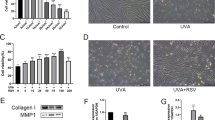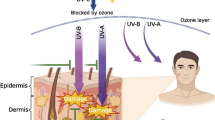Summary
Comprehensive analysis of the mechanical properties of rat skin revealed the “step phenomenon”. This particular observation was made after constant strain rate (analysis of stress strain curves) as well as after constant load (creep experiments). Relative low extensions or low loads were necessary to provoke the steps. In most cases two, sometimes three steps were observed. The step phenomenon was found mainly in skin strips punched out perpendicularly to the body axis. Probably some bonds in the fibrous network are broken giving way to additional elongation whereafter stronger links take over the stress. Since earlier studies demonstrated a pronounced influence of age and of desmotropic drugs on mechanical properties at ultimate load, e.g., tensile strength, ultimate modulus of elasticity, and ultimate strain, also the step phenomenon was studied under these conditions. In stress-strain experiments most of the steps were found at the ages of 2 and 4 months. Total stress loss and total work loss due to the steps were the highest at the age of 4 months. If, however, these values were calculated as percentage of ultimate values, the highest figures were found in young animals. Elongation gain due to the steps also showed a maximum at time of maturation, e.g., 4 months. Similar findings were achieved in creep experiments at medium load (200 g). After treatment with prednisolone acetate more steps and after treatment with d-penicillamine fewer steps were observed. In stress-strain experiments total stress loss and total work loss due to steps were more than twice as high than controls after prednisolone treatment and only one half after d-penicillamine. If calculated as percentage of ultimate stress or percentage of work input, these changes disappeared because of similar changes at ultimate load. However, elongation gain due to steps, which was not significantly influenced by prednisolone acetate but significantly decreased by d-penicillamine, showed the same changes when calculated as percentage of ultimate strain. Under all conditions the step phenomenon mainly influenced the extension parameters. The data presented here confirm earlier observations that mechanical properties at low loads or low and medium extensions show at least to some extent a different pattern under the influence of maturation and age and after treatment with desmotropic drugs compared to the mechanical parameters at ultimate load.
Zusammenfassung
Bei eingehenden Untersuchungen der Biomechanik der Haut von Ratten zeigte sich ein eigenartiges Verhalten, das sowohl bei konstanter Abzugsgeschwindigkeit (Kraftdehnungsexperimente) als auch bei konstanter Belastung (Kriechexperimente) auftrat. Bei konstanter Dehnung nahm die Spannung nicht kontinuierlich zu, sondern fiel 2 oder 3 mal partiell ab, bevor der steile Teil der Kraftdehnungskurve einsetzte. Dieses Verhalten, das als Stufenphänomen bezeichnet wird, wird bei geringen bis mittleren Dehnungen und relativ geringen Belastungen ausgelöst. In den meisten Fällen wurden 2, manchmal auch 3 Stufen beobachtet. Die Möglichkeit von Artefakten wurde ausgeschlossen. Das Phänomen trat hauptsächlich an Proben der Rückenhaut von Ratten, die quer zur Körperrichtung ausgestanzt waren, auf. Es kann dadurch erklärt werden, daß im Fasernetzwerk der Haut bestimmte Bindungen reißen und damit eine momentane zusätzliche Verlängerung eintritt, bis andere Bindungselemente die Zugkräfte aufnehmen. Da frühere Untersuchungen einen ausgeprägten Einfluß auf Alterung und Reifung sowie von desmotropen Substanzen auf die mechanischen Eigenschaften beim A briß, wie z. B. Reißfestigkeit, Elastizitätsmodul und Dehnung bis zum Abriß, gezeigt haben, lag es nahe, auch das Stufenphänomen unter diesen Bedingungen zu untersuchen. Bei den Kraftdehnungsexperimenten wurden die meisten Stufen in einem Alter von 2 bis 4 Monaten gefunden. Der den Stufen zuzurechnende, aufsummierte Spannungsverlust und der aufsummierte Energieverlust waren am höchsten in einem Alter von 4 Monaten. Wenn jedoch diese Werte als Prozentsatz der Werte beim Abriß berechnet wurden, so wurden die höchsten Zahlen bei jungen Tieren gefunden. Die auf die Stufen zurückzuführende Dehnungszunahme zeigte ebenfalls ein Maximum zur Zeit der Reifung, also nach 4 Monaten. Ähnliche Befunde wurden in den Kriechexperimenten erhoben, wenn mit einer mittleren Belastung von 200 g gearbeitet wurde. Nach Behandlung mit Prednisolonazetat wurden mehr und nach Behandlung mit d-Penicillamin weniger Stufen beobachtet. In den Kraftdehnungsexperimenten waren der aufsummierte Spannungsverlust und der aufsummierte Energieverlust bei Prednisolon-behandelten Ratten mehr als doppelt so hoch als bei den Kontrollen und etwa nur die Hälfte nach d-Penicillamin-Behandlung. Wenn diese Werte als Prozentsatz der Werte beim Abriß berechnet wurden, so verschwanden die Unterschiede, da die Veränderungen von Reißfestigkeit und Gesamtenergieaufnahme gleichgerichtet waren. Jedoch die auf die Stufen zurückzuführende Dehnungszunahme, die durch d-Penicillamin signifikant erniedrigt und durch Prednisolonacetat statistisch nicht signifikant erhöht war, zeigte diese Veränderungen auch, wenn sie als Prozentsatz der Dehnung beim Abriß berechnet wurde. Unter allen hier geprüften Bedingungen beeinflußte das Stufenphänomen hauptsächlich die Dehnungsparameter. Die hier berichteten Befunde bestätigten frühere Beobachtungen, daß die mechanischen Eigenschaften bei geringer Belastung oder geringer und mittlerer Dehnung zumindest teilweise ein verschiedenes Verhalten zeigen, sowohl unter dem Einfluß der Reifung und der Alterung als auch nach Behandlung mit desmotropen Substanzen, als es für die mechanischen Eigenschaften beim Abriß der Proben gefunden wurde.
Similar content being viewed by others
References
Wöhlisch, E., du Mesnil de Rochemont, R., Gerschler, H.: Untersuchungen über die elastischen Eigenschaften tierischer Gewebe. I. Z. Biol. 85, 311–326 (1926)
Rollhäuser, H.: Die Zugfestigkeit der menschlichen Haut. Gegenbaurs morph. Jb. 90, 249–260 (1950)
Wenzel, H. G.: Untersuchungen einiger mechanischer Eigenschaften der Haut, insbesondere der Striae cutis distensae. Virch. Arch. Path. Anat. Physiol. 317, 654–706 (1950)
Jansen, L. H., Rottier, P. B.: Some mechanical properties of human abdominal skin measured on excised strips. Dermatologica, 117, 65 (1958)
Fry, P., Harkness, M. L. R., Harkness, R. D.: Mechanical properties of the collagenous framework of skin in rats of different ages. Am. J. Physiol. 206, 1425–1429 (1964)
Ridge, M. D., Wright, V.: The descriptions of skin stiffness. Biorheology 2, 67–74 (1964)
Mendoza, S. A., Milch, R. A.: Age variations of nominal tensile strength of Wistar rat skins. Gerontologia 10, 42 (1964/65)
Kenedi, R. M., Gibson, T., Daly, C. H.: Bio-engineering studies of the human skin II. In: Biomechanics and related bioengineering topics. Proceedings of a symposium held in Glasgow. Sept. 1964, Kenedi, R. M. (ed.), Oxford-London: Pergamon Press 1965
Stüttgen, G.: Die mechanischen Eigenschaften der Haut. In: Die normale und pathologische Physiologie der Haut, pp. 18–28. Stuttgart: Fischer 1965
Kenedi, R. M., Gibson, T., Daly, C. H., Abrahams, M.: Biomechanical characteristics of human skin and costal-cartilage. Proc. Fed. Am. Soc. Exp. 25, 1084–1087 (1966)
Grahame, R., Holt, P. J. L.: The influence of ageing on the in vivo elasticity of human skin. Gerontologia 15, 121 (1969)
Vogel, H. G.: Zur Wirkung von Hormonen auf physikalische und chemische Eigenschaften des Binde-und Stützgewebes. Arzneimittel-Forsch. 19, 1495; 1732; 1790; 1981 (1969)
Vogel, H. G., Kobelt, D., Korting, G. W., Holzmann, H.: Prufung der Festigkeitseigenschaften von Rattenhaut in Abhängigkeit von Lebensalter und Geschlecht. Arch. klin. Exp. Dermatol 239, 296–306 (1970)
Vogel, H. G.: Antagonistic effect of aminoacetonitrile and prednisolone on mechanical properties of rat skin. Biochim. Biophysiol. Acta 252, 580–585 (1971)
Vogel, H. G.: Influence of age, treatment with corticosteroids and strain rate on mechanical properties of rat skin. Biochim. Biophysiol. Acta 286, 79–93 (1972)
Vogel, H. G.: Correlation between tensile strength and collagen content in rat skin. Effect of age and cortisol treatment. Conn. Tiss. Res. 2, 177–182 (1974)
Vogel, H. G.: Altersabhängige Veränderungen der mechanischen und biochemischen Eigenschaften der Cutis bei Ratten. Akt. Gerontol. 6, 477–487 (1976)
Hirsch, C., Sonnerup, L.: Macroscopic rheology in collagen material. J. Biomech. 1, 13–18 (1968)
Jamison, C. E., Marangoni, R. D., Glaser, A. A.: Viscoelastic properties of soft tissue by discrete model characterization. J. Biomech. 1, 33–46 (1968)
Viidik, A.: A rheological model for uncalcified parallel-fibred collagenous tissue. J. Biomech. 1, 3–11 (1968)
Frisen, M., Mägi, M., Sonnerup, L., Viidik, A.: Rheological analysis of soft collagenous tissue. Part I: Theoretical considerations. J. Biomech. 2, 13–20 (1969a)
Frisen, M., Mägi, M., Sonnerup, L., Viidik, A.: Rheological analysis of soft collagenous tissue. Part II: Experimental evaluations and verifications. J. Biomech. 2, 21–28 (1969b)
Veronda, D. R., Westmann, R. A.: Mechanical characterization of skin-finite deformations. J. Biomech. 3, 111–124 (1970)
Danielson, D. A.: Human skin as an elastic membrane J. Biochem. 6, 539–546 (1973)
Soong, T. T., Huang, W. N.: A stochastic model of biological tissue elasticity in simple elongation. J. Biomech. 6, 451–458 (1973)
Jenkins, R. B., Little, R. W.: A constitutive equation for parallel-fibered elastic tissue. J. Biomech. 7, 397–402 (1974)
Lanir, Y., Fung, Y. C.: Two-dimensional mechanical properties of rabbit skin. II. Experimental results. J. Biomech. 7, 171–182 (1974)
Vogel, H. G.: Measurement of some viscoelastic properties of rat skin following repeated load. Conn. Tiss. Res. 4, 163–168 (1976)
Vogel, H. G., Hilgner, W.: Analysis of the low part of stress-strain curves in rat skin. Influence of age and desmotropic drugs. Arch. Dermatol. Res. 258, 141–150 (1977)
Vogel, H. G., Hilgner, W.: The “step phenomenon” as observed in animal skin. J. Biomech. 12, 75–81 (1979)
Vogel, H. G.: Beeinflussung der mechanischen Eigenschaften der Haut von Ratten durch Hormone. Arzneimittel-Forsch. 20, 1849–1857 (1970)
Vogel, H. G.: Stress relaxation in rat skin after treatment with hormones. J. Med. 4, 19–27 (1973)
Vogel, H. G.: Tensile strength, relaxation and mechanical recovery in rat skin as influenced by maturation and age. J. Med. 7, 177–188 (1976)
Vogel, H. G.: Effects of d-penicillamine and prednisolone on connective tissue in rats. Conn. Tiss. Res. 1, 283–289 (1972)
Vogel, H. G.: Collagen and mechanical strength in various organs of rats treated with d-penicillamine or amino-acetonitrile. Conn. Tiss. Res. 3, 237–244 (1975)
Vogel, H. G.: Strain of rat skin at constant load (creep experiments). Influence of age and desmotropic agents. Gerontology 23, 77–86 (1977)
Vogel, H. G., Hilgner, W.: Viscoelastic behaviour of rat skin after repeated and stepwise increased strain. Bioengineering and the skin. Quarterly Newsletter 1, 22–33 (1978)
Author information
Authors and Affiliations
Rights and permissions
About this article
Cite this article
Vogel, H.G., Hilgner, W. Influence of age and of desmotropic drugs on the step phenomenon observed in rat skin. Arch Dermatol Res 264, 225–241 (1979). https://doi.org/10.1007/BF00431134
Received:
Issue Date:
DOI: https://doi.org/10.1007/BF00431134




